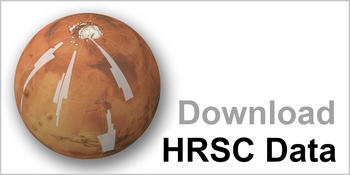Department of Earth Sciences
Service Navigation
Flight around Jezero Crater – Special PR 2023
This film was created using an image mosaic made from single orbit observations of the High Resolution Stereo Camera (HRSC) on board ESA’s Mars Express mission. The film shows a flight over Jezero crater and its surrounding region, the landing site of the rover "Perseverance" of the NASA Mars 2020 Mission. HRSC’s high-resolution digital terrain models have made important contributions to the selection of numerous landing sites on Mars, including that of the Mars 2020 mission. Accurate topographical information is critical for ensuring a safe landing.
Credit: ESA/DLR/FU Berlin & NASA/JPL-Caltech/MSSS (CC BY-SA 3.0 IGO)
| Animation "Flight around Jezero Crater" [551 MB] (download in full resolution) | |
| Animation "Flight around Jezero Crater - annotated" [551 MB] (download in full resolution) |
Image Processing
The base images consist of a merged data-set from two different instruments. The Mars Express High-Resolution Stereo Camera Mars Chart (HMC30) data are used as reference data-sets providing the geodetically controlled topography base and the seamless base imagery covering the complete region. In addition, 33 single images of the Mars Reconnaissance Orbiter Context Camera with a resolution of up to 5 m were used.
The single CTX images have been radiometrically normalised using the HRSC MC13 tile as brightness reference. The two data-sets have been colorised by the HRSC color channels using pan-sharpening techniques.This mosaic image is then combined with topography information from the digital terrain model (DTM) to generate a three-dimensional landscape.
Finally, for every second of the movie 50 separate frames are rendered following a pre-defined camera path in the scene. The vertical exaggeration used for the animation is 3-fold. Atmospheric effects, i. e. clouds and haze have been added to conceal the limits of the terrain model. The haze starts building up at 200 km distance.
High Resolution Stereo Camera
The High Resolution Stereo Camera was developed at the German Aerospace Center (DLR) and built in collaboration with partners in industry (EADS Astrium, Lewicki Microelectronic GmbH and Jena-Optronik GmbH). The science team, which is headed by Principal Investigator (PI) Dr. Thomas Roatsch, consists of 52 co-investigators from 34 institutions and 11 countries. The camera is operated by the DLR Institute of Planetary Research in Berlin-Adlershof.
The systematic processing of the camera data took place at the DLR Institute for Planetary Research in Berlin-Adlershof. The working group of Planetary Science and Remote Sensing at Freie Universität Berlin used the data to create the film shown here.
Images: ESA/DLR/FU Berlin & NASA/JPL-Caltech/MSSS (CC BY-SA 3.0 IGO)
Copyright Notice:
Where expressly stated, images are licensed under the Creative Commons Attribution-ShareAlike 3.0 IGO (CC BY-SA 3.0 IGO) licence. The user is allowed to reproduce, distribute, adapt, translate and publicly perform it, without explicit permission, provided that the content is accompanied by an acknowledgement that the source is credited as 'ESA/DLR/FU Berlin', a direct link to the license text is provided and that it is clearly indicated if changes were made to the original content. Adaptation / translation / derivatives must be distributed under the same license terms as this publication.
HMC30 products
The HMC30 products include multi-orbit DTMs and orthorectified image mosaics derived from HRSC images, as well as follow-up products such as pan-sharpened color mosaics. HMC30 data products are organized according to a modified version of the USGS MC-30 tiling scheme. All HMC30 products are based on bundle-block adjustment of the stereo images, are registered to the global MOLA reference.
Former lake in Jezero Crater
The 48 km wide Jezero Crater is located on the boundary between the ancient highland region of Terra Sabaea and the similarly aged Isidis impact basin, whose present-day Isidis Planitia surface was formed primarily by significantly younger deposits.
The nearby Nili Fossae graben system, which roughly traces the shape of the Isidis basin rim through its curvature, was formed precisely by this impact as a result of tectonic fractures. Adjoining Jezero Crater to the southwest is the volcanic region of Syrtis Major. The dark, bluish-black areas are covered by a layer of ancient volcanic ash that is widely dispersed by the wind and often piles up into impressive dune fields.
The Jezero Crater crater rim is breached by three valleys which were former rivers. Neretva Vallis and Sava Vallis were inflow channels that have created two deltas on the western and northwestern rim of the crater, which are also considered evidence for the existence of a former lake.
Pliva Vallis in the east of Jezero Crater was an outflow channel through which water was discharged from the crater. This is why this former crater lake is referred to as an ‘open basin lake’. These lakes were once numerous on Mars. Compared to closed basins (with inflow but no outflow), they are interesting because they were freshwater lakes with a stable water level. Lakes in closed basins, on the other hand, were subjected to more frequent periods of drying out, which turned them into salt lakes, thus making them less promising in the search for conditions that are conducive to life.
← For more information and a virtual hiking tour through Jezero Crater click on the button.
To explore the HMC30 products click on the button. →



